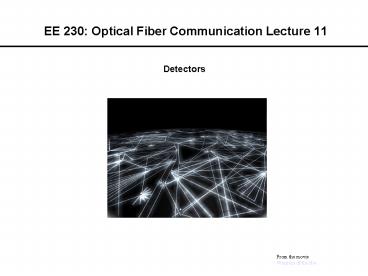EE 230: Optical Fiber Communication Lecture 11 - PowerPoint PPT Presentation
1 / 27
Title:
EE 230: Optical Fiber Communication Lecture 11
Description:
High-energy electron-hole pairs ionize other sites to multiply the current ... Eliminates carrier generation in field free regions ... – PowerPoint PPT presentation
Number of Views:243
Avg rating:3.0/5.0
Title: EE 230: Optical Fiber Communication Lecture 11
1
EE 230 Optical Fiber Communication Lecture 11
Detectors
From the movie Warriors of the Net
2
Detector Technologies
Features
Layer Structure
Simple, Planar, Low Capacitance Low Quantum
Efficiency
MSM (Metal Semiconductor Metal) PIN APD Wav
eguide
Semiinsulating GaAs
Contact InGaAsP p 5x1018 Absorption
InGaAs n- 5x1014 Contact InP
n 1x1019
Trade-off Between Quantum efficiency and Speed
Gain-Bandwidth 120GHz Low Noise Difficult to
make Complex
Contact InP p
1x1018 Multiplication InP n
5x1016 Transition InGaAsP n
1x1016 Absorption InGaAs n
5x1014 Contact InP n
1x1018 Substrate InP Semi
insulating
High efficiency High speed Difficult to couple
into
Absorption Layer
Guide Layers
Absorption Layer Contact layers
Key
3
Photo Detection Principles
Bias voltage usually needed to fully deplete the
intrinsic I region for high speed operation
Device Layer Structure
Band Diagram showing carrier movement in E-field
Light intensity as a function of distance below
the surface
Carriers absorbed here must diffuse to the
intrinsic layer before they recombine if they are
to contribute to the photocurrent. Slow
diffusion can lead to slow tails in the
temporal response.
(Hitachi Opto Data Book)
4
Current-Voltage Characteristic for a Photodiode
5
Characteristics of Photodetectors
Internal Quantum Efficiency External
Quantum efficiency Responsivity
Photocurrent
Fraction Transmitted into Detector
Incident Photon Flux (/sec)
Fraction absorbed in detection region
6
Responsivity
- Output current per unit incident light power
typically 0.5 A/W
7
Photodiode Responsivity
8
Detector Sensitivity vs. Wavelength
Photodiode Responsivity vs. Wavelength for
various materials (Albrecht et al 1986)
Absorption coefficient vs. Wavelength for
several materials (Bowers 1987)
9
PIN photodiodes
Energy-band diagram
p-n junction
Electrical Circuit
10
Basic PIN Photodiode Structure
Rear Illuminated Photodiode
Front Illuminated Photodiode
11
PIN Diode Structures
Diffused Type (Makiuchi et al. 1990)
Etched Mesa Structure (Wey et al. 1991)
Diffused Type (Dupis et al 1986)
Diffused structures tend to have lower dark
current than mesa etched structures although they
are more difficult to integrate with electronic
devices because an additional high temperature
processing step is required.
12
Avalanche Photodiodes (APDs)
- High resistivity p-doped layer increases electric
field across absorbing region - High-energy electron-hole pairs ionize other
sites to multiply the current - Leads to greater sensitivity
13
APD Detectors
Signal Current
APD Structure and field distribution (Albrecht
1986)
14
APDs Continued
15
Detector Equivalent Circuits
PIN
IphPhotocurrent generated by detector CdDetector
Capacitance IdDark Current InMultiplied noise
current in APD RdBulk and contact resistance
16
MSM Detectors
Light
Schottky barrier gate metal
- Simple to fabricate
- Quantum efficiency Medium
- Problem Shadowing of absorption
- region by contacts
- Capacitance Low
- Bandwidth High
- Can be increased by thinning absorption layer and
- backing with a non absorbing material.
Electrodes - must be moved closer to reduce transit time.
- Compatible with standard electronic processes
- GaAs FETS and HEMTs
- InGaAs/InAlAs/InP HEMTs
Semi insulating GaAs
Simplest Version
To increase speed decrease electrode spacing and
absorption depth
Absorption layer
E Field penetrates for electrode spacing into
material
Non absorbing substrate
17
Waveguide Photodetectors
- Waveguide detectors are suited for very high
bandwidth applications - Overcomes low absorption limitations
- Eliminates carrier generation in field free
regions - Decouples transit time from quantum efficiency
- Low capacitance
- More difficult optical coupling
(Bowers IEEE 1987)
18
Carrier transit time
- Transit time is a function of depletion width and
carrier drift velocity - td w/vd
19
Detector Capacitance
xp
xn
Capacitance must be minimized for high
sensitivity (low noise) and for high speed
operation Minimize by using the smallest light
collecting area consistent with efficient
collection of the incident light Minimize by
putting low doped I region between the P and N
doped regions to increase W, the depletion
width W can be increased until field required to
fully deplete causes excessive dark current, or
carrier transit time begins to limit speed.
P
N
p-n junction
20
Bandwidth limit
- C?0K A/w
- where K is dielectric constant, A is area, w is
depletion width, and ?0 is the permittivity of
free space (8.85 pF/m) - B 1/2?RC
21
PIN Bandwidth and Efficiency Tradeoff
Transit time ?W/vsat vsatsaturation
velocity2x107 cm/s R-C Limitation Responsivi
ty Diffusion ?4 ns/µm (slow)
22
Dark Current
Surface Leakage
Bulk Leakage
Surface Leakage Ohmic Conduction Generation-reco
mbination via surface states
Bulk Leakage Diffusion Generation-Recombination
Tunneling
Usually not a significant noise source at high
bandwidths for PIN Structures High dark current
can indicate poor potential reliability In APDs
its multiplication can be significant
23
Signal to Noise Ratio
- ip average signal photocurrent level
- based on modulation index m where
24
Optimum value of M
- where F(M) Mx and m1
25
Noise Equivalent Power (NEP)
- Signal power where S/N1
- Units are W/Hz1/2
26
Typical Characteristics of P-I-N and Avalanche
photodiodes
27
Comparisons
- PIN gives higher bandwidth and bit rate
- APD gives higher sensitivity
- Si works only up to 1100 nm InGaAs up to 1700,
Ge up to 1800 - InGaAs has higher ? for PIN, but Ge has higher M
for APD - InGaAs has lower dark current































